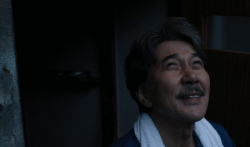Nicholas Garrigan (James McAvoy) stands at a globe. With eyes shut, he spins it, mumbling that he’ll go wherever his finger lands. It lands on Canada. He spins the globe again. This time it lands on Uganda.
The Last King of Scotland follows Nicholas Garrigan, a young Scot fresh out of med school. Stifled by his stuffy home, Garrigan decides to go to Uganda and soon becomes one of the men closest to Idi Amin (Forest Whitaker) at the beginning of his tyrannical reign.
The next scene lands a smiling Garrigan on a noisy bus ambling through the country villages of Uganda. The washed-out colors of Scotland have been replaced with earthy colors, and beating drums accompany the quick shots from the bus to the countryside to the people in the villages back to Garrigan in the bus. This is Nicholas Garrigan in Uganda: naive, impulsive and utterly exhilarated by his surroundings and their possibilities.
Idi Amin (Forest Whitaker) first comes on screen when he visits the village where Garrigan works. Garrigan agrees to be Amin’s personal physician, and he quickly becomes one of Amin’s closest advisors. Amin throws lavish parties and gives Garrigan a Mercedes, and Garrigan doesn’t realize anything is wrong until it’s too late. As Amin’s paranoia and madness increases, Garrigan’s inadvertent complicity entrenches him deeper in the atrocities that he hardly realizes are going on around him.
The Last King of Scotland is shot through the eyes of Garrigan, whose perspective is limited at best. Granted, as Idi Amin’s personal physician, Garrigan has one of the closest looks someone could have at Amin’s progressive madness, but in that narrow scope the real terror of Amin is lost on the audience. During his reign, Amin murdered at least 300,000 Ugandans, including women and children. Besides a discussion Garrigan has with Nigel Stone (Simon McBurny), a skeptic of Amin’s, in which Stone shows Garrigan pictures of Amin’s murders and tells him, “right under our noses, he’s wiping out the entire political opposition,” not much is indicated of the widespread havoc Amin wreaked on his country. At the end of the movie there is a postscript that tells the audience of the 300,000 murdered, which would have surprised me, had I not known about Amin before seeing the movie.
Aside from this omission the cinematography is the movie’s only weakness. MacDonald essentially had two tricks up his sleeve: one-on-one close-ups and montages, and by the middle of the movie both become tiresome. The initial montages are effective in setting the scenes; when Garrigan arrives in Uganda, it efficiently surveys the landscape and conveys the mood. However, as the film progresses, MacDonald continues to employ the same tactics in every scene that covers more area than the size of a room and the system overloads. Add to that the gory, gritty images of the last scenes and it’s enough to make you want to tear your hair out.
For the smaller scenes of just a few people, MacDonald has the camera constantly moving, zooming in on one face and then sweeping quickly across to the other person. It’s effective, but only for a while. When MacDonald becomes overbearing, the shots lose their impact.
Nonetheless, The Last King of Scotland is a compelling story. While the beginning is too drawn out, the actors’ performances, particularly Whitaker’s simultaneously lovable and terrifying portrayal of Amin, and the story itself save MacDonald’s movie from mere mediocrity.




